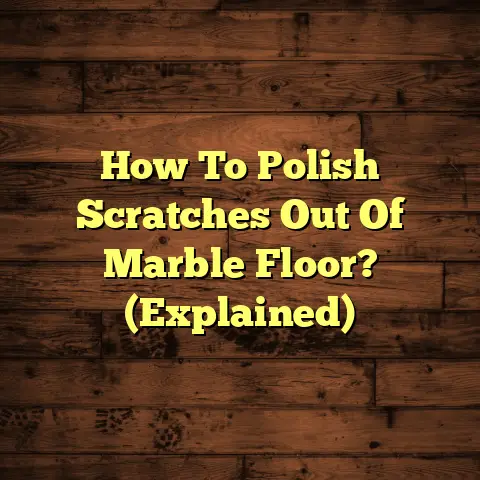Join Hardwood & Tile? (2 Gaps To Avoid NOW!)
It’s a fantastic way to bring character, style, and functionality to your home. But let’s be real, it’s not always a walk in the park.
If you’re not careful, you can end up with some serious issues.
I’m talking about gaps – not just the physical kind, but also the “oops, I didn’t see that coming” kind.
In this article, I’ll share my insights on how to avoid two critical gaps when joining hardwood and tile. I’ll share stories, tips, and tricks I’ve learned from years on the job.
Ready to dive in? Let’s do it!
Section 1: Understanding the Appeal of Hardwood and Tile
Aesthetic Harmony
Think about it: the warm, inviting tones of hardwood meeting the cool, sleek surface of tile. It’s a match made in design heaven!
I’ve seen this combo work wonders in all sorts of homes.
In rustic designs, the natural grain of hardwood complements the earthy feel of slate or terracotta tile.
For modern spaces, pairing light-colored hardwood with large-format porcelain tile creates a clean, minimalist look.
And in eclectic designs? The possibilities are endless! You can mix and match colors, textures, and patterns to create a truly unique space.
It’s all about finding that perfect balance.
I remember one project where the homeowner wanted a “coastal chic” vibe. We used light-washed oak hardwood in the living room and a beautiful blue-gray tile in the kitchen.
The transition was seamless, and the effect was stunning!
Functional Benefits
Let’s talk practicality. Hardwood is warm, comfortable, and adds a touch of elegance to any room.
Tile, on the other hand, is durable, water-resistant, and easy to clean.
Combining the two allows you to cater to different areas of your home with the perfect flooring solution.
I often recommend hardwood for living rooms, bedrooms, and hallways – spaces where comfort is key.
Tile is perfect for kitchens, bathrooms, mudrooms, and entryways – areas that see a lot of traffic and moisture.
For example, I recently worked on a home where the family had young kids and pets. We installed hardwood in the main living areas for a cozy feel, but used durable porcelain tile in the entryway and kitchen to handle all the spills and muddy paws.
It was the perfect solution for their lifestyle!
Market Trends
Homeowners are increasingly embracing mixed materials for a more personalized aesthetic.
Gone are the days of cookie-cutter homes with the same flooring throughout. People want character, and they want it now!
According to a recent survey by the National Association of Realtors, homes with hardwood flooring tend to sell for approximately 2.5% more than homes without hardwood flooring.
This shows that homeowners want to invest in quality and design.
Mixing hardwood and tile is a great way to achieve both.
I’ve noticed a huge increase in requests for this type of flooring combination in the past few years.
People are getting more creative with their designs, and they’re not afraid to experiment with different materials.
That’s what I love about this industry – it’s always evolving!
Section 2: Gap 1 – Inconsistent Transition
Identifying the Problem
Okay, let’s get down to the nitty-gritty.
The transition from hardwood to tile can be tricky.
I’ve seen it all: height differences, uneven surfaces, misaligned patterns… the list goes on.
One of the most common issues is a height difference between the two flooring types.
Hardwood is typically thinner than tile, especially when you factor in the mortar bed needed for tile installation.
This can create a noticeable lip or bump at the transition point, which is not only unsightly but also a tripping hazard.
Another common problem is uneven surfaces.
If the subfloor isn’t perfectly level, it can cause the hardwood and tile to sit at different heights, creating an uneven transition.
Misaligned patterns are another big issue.
If the patterns on the hardwood and tile don’t line up properly, it can create a jarring visual effect.
Visual Disruption
An inconsistent transition can ruin the entire look of your home.
It can make the space feel disjointed and unfinished.
I’ve seen homeowners spend thousands of dollars on beautiful hardwood and tile, only to have the entire project ruined by a poorly executed transition.
It’s heartbreaking!
Imagine walking into a room with stunning hardwood floors, only to be met with a clunky, uneven transition to a beautiful tile entryway.
It’s like a jarring note in a beautiful song.
It just doesn’t feel right.
I remember one project where the homeowner tried to save money by installing the transition strip themselves.
They didn’t measure properly, and the strip ended up being too short.
The result was a noticeable gap between the hardwood and tile, which looked sloppy and unprofessional.
Solutions to Avoid
So, how do you avoid these pitfalls? Planning is key.
First, measure everything!
Accurate measurements are essential for ensuring a smooth transition.
Before you even start installing the flooring, take the time to measure the height of both the hardwood and tile.
This will help you determine if you need to adjust the subfloor to create a level surface.
Next, choose the right transition strip or threshold.
There are many different types of transition strips available, each designed for specific situations.
For example, if there’s a slight height difference between the hardwood and tile, you can use a ramped transition strip to create a gradual slope.
If the hardwood and tile are at the same height, you can use a T-molding to create a seamless transition.
I personally love using Schluter profiles for transitions.
They offer a wide variety of options that are both functional and aesthetically pleasing.
Finally, take your time!
Don’t rush the installation process.
Pay attention to detail and make sure everything is aligned properly.
Section 3: Gap 2 – Inadequate Moisture Protection
Understanding Moisture Issues
Moisture is the enemy of hardwood.
It can cause warping, cupping, and even mold growth.
When you combine hardwood and tile, you need to be extra careful to protect the hardwood from moisture.
Tile is water-resistant, but it’s not waterproof.
Water can seep through the grout lines and underneath the tile, potentially damaging the subfloor and the surrounding hardwood.
This is especially true in areas like kitchens and bathrooms, where spills are common.
I’ve seen countless hardwood floors ruined by water damage.
It’s a costly and frustrating experience that can be easily avoided with proper precautions.
Consequences of Neglect
If moisture isn’t adequately managed, the consequences can be severe.
Warping of hardwood is one of the most common problems.
When hardwood absorbs moisture, it expands.
If it expands too much, it can warp and buckle, creating an uneven surface.
Mold growth is another serious concern.
Mold thrives in damp environments.
If moisture gets trapped underneath the hardwood or tile, it can create the perfect breeding ground for mold.
Deterioration of adhesive used for tiles is also a possibility.
Excessive moisture can weaken the adhesive, causing the tiles to loosen and crack.
I once had to replace an entire hardwood floor because of water damage caused by a leaky dishwasher.
The homeowner had ignored the problem for months, and by the time they called me, the damage was extensive.
Preventive Measures
So, how do you prevent moisture-related issues?
Proper sealing of hardwood is essential.
Apply several coats of a high-quality sealant to protect the hardwood from moisture.
Make sure to seal all edges and seams.
Installation of moisture barriers is also crucial.
A moisture barrier is a thin layer of plastic or rubber that is installed underneath the hardwood and tile.
This barrier prevents moisture from seeping up from the subfloor and damaging the flooring.
Regular maintenance practices are also important.
Clean up spills immediately and avoid using excessive water when cleaning the floor.
I always recommend using a damp mop with a pH-neutral cleaner specifically designed for hardwood and tile.
I also advise homeowners to inspect their flooring regularly for any signs of moisture damage.
Look for discoloration, warping, or mold growth.
If you notice any of these signs, take action immediately to prevent further damage.
Section 4: Design Considerations for a Cohesive Look
Color Coordination
Choosing the right colors is crucial for creating a cohesive look when combining hardwood and tile.
The goal is to create a harmonious environment that feels balanced and inviting.
One approach is to choose colors that are complementary to each other.
For example, you could pair warm-toned hardwood with cool-toned tile, or vice versa.
Another approach is to choose colors that are in the same color family but have different shades or tones.
For example, you could pair light-colored hardwood with dark-colored tile, or vice versa.
I always recommend bringing samples of the hardwood and tile to your home and seeing how they look in the natural light.
The lighting in your home can significantly affect how colors appear.
Don’t be afraid to experiment with different color combinations until you find one that you love.
Pattern and Texture
Varying textures and patterns can be used strategically to accentuate the transition between hardwood and tile.
For example, you could use a patterned tile to create a focal point in a room and then transition to a smooth, solid-colored hardwood.
Or, you could use a textured hardwood to add visual interest to a space and then transition to a smooth, polished tile.
I love using different patterns and textures to create a sense of depth and dimension in a room.
For example, I recently worked on a project where we used a herringbone pattern for the hardwood and a subway tile pattern for the kitchen backsplash.
The combination of the two patterns created a visually stunning effect.
Room Layout
Laying out rooms to maximize the strengths of both flooring types can make a huge difference in the overall look and feel of your home.
Think about how you use each room and choose the flooring that is best suited for that purpose.
For example, you could use hardwood in the living room to create a cozy and inviting space and then transition to tile in the kitchen for durability and easy maintenance.
Or, you could use tile in the entryway to create a durable and water-resistant surface and then transition to hardwood in the hallway to add warmth and comfort.
I always advise homeowners to consider the flow of traffic in their home when choosing flooring materials.
Choose materials that are durable and easy to clean in high-traffic areas.
Section 5: Professional Installation vs. DIY
Pros and Cons of Each Method
So, should you hire a professional or tackle the project yourself?
That’s a big question, and the answer depends on your skills, experience, and budget.
Hiring a professional has several advantages.
They have the expertise and experience to ensure a flawless installation.
They also have the right tools and equipment to get the job done quickly and efficiently.
However, hiring a professional can be expensive.
DIY installation can save you money, but it also comes with risks.
If you don’t have the necessary skills and experience, you could end up making costly mistakes.
I always tell homeowners to be realistic about their abilities.
If you’re not comfortable with the idea of installing hardwood and tile yourself, it’s best to hire a professional.
Finding the Right Professional
If you decide to hire a professional, it’s important to choose someone who is qualified and experienced.
Ask for referrals from friends, family, or neighbors.
Check online reviews and ratings.
Make sure the installer is licensed and insured.
Ask for a written estimate that includes all costs, including labor, materials, and disposal fees.
Don’t be afraid to ask questions.
A good installer will be happy to answer your questions and explain the installation process in detail.
I always recommend getting at least three estimates before making a decision.
DIY Best Practices
If you’re considering a DIY approach, here are some essential tips for a successful installation.
First, do your research.
Watch videos, read articles, and talk to experienced DIYers.
Make sure you understand the installation process before you start.
Next, gather the right tools and materials.
You’ll need a variety of tools, including a saw, a drill, a level, a measuring tape, and a trowel.
You’ll also need the right materials, including hardwood, tile, mortar, grout, sealant, and transition strips.
Follow the manufacturer’s instructions carefully.
Improper installation can void the warranty and lead to costly repairs.
Finally, take your time and be patient.
DIY projects can be challenging, but they can also be rewarding.
Don’t get discouraged if you make mistakes.
Learn from them and keep going.
Conclusion
Combining hardwood and tile can create a beautiful and functional space in your home.
But it’s important to avoid the two critical gaps I’ve discussed in this article: inconsistent transitions and inadequate moisture protection.
By planning carefully, choosing the right materials, and following best practices, you can achieve a seamless and long-lasting flooring solution.
Whether you choose to hire a professional or tackle the project yourself, I hope this article has given you the knowledge and confidence to create the home of your dreams.
Now go out there and make some beautiful floors!
If you have any questions, feel free to leave a comment below.





